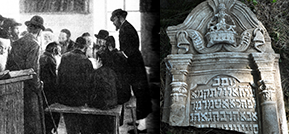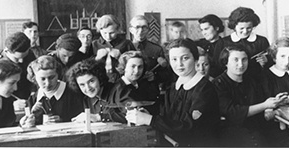The seventh annual expedition of the Jewish Galicia and Bukovina Organization set out on August 2nd, 2015. The 15 members of the expedition – students and graduate of hesder yeshivas, students from the Catholic University of Lviv and staff members from Israel and St. Petersburg guided by Dr. Boris Khaimovich (The Hebrew University of Jerusalem)– spent two weeks working in the Jewish cemetery in Kuty, a town situated on the border between Galicia and Bukovina. Kuty was a relatively small town, numbering a general population of about 6,740 at its peak, around 1910. About half of this number were Jews. However, the community of Kuty earned a reputation far beyond its modest size due to famous personages who originated from there. The best known of these was the rabbi of the city and a famous kabbalist, R. Moshe ben Menachem Mendel Kitever, who headed a group of kabbalists during the first half of the 18th century. No less famous was the name of his most notable student, R. Abraham Gershon of Kuty, a kabbalist and scholar and the brother-in-law of the Ba’al Shem Tov. According to Hassidic tradition, the Ba’al Shem Tov spent the years of his “hiding” close to Kuty as well, where he supported himself by digging up and selling clay.
The Jewish community of the town began to develop at the beginning of the 18th century, when Kuty received city privileges, leading to its settling by Armenian and Jewish merchants and tradesmen. The Jewish cemetery was consecrated at this time, and the building of the central synagogue begun.
The Jews of Kuty made their living through trade, tannery, carriage making and different crafts. Toward the end of the 19th century the Jewish population of Kuty also included industrialists and owners of flour-mills. A small number of Jews occupied administrative posts in governmental and municipal institutions.
Most of the Jews in Kuty lived in the center of the town, near the market square and west of it, where the central synagogue and two smaller prayer houses were situated. The city also included study halls and Hassidic kloizes, of the Vizhnitz, Kosów and Czortków Hassidic strands.
During the First World War the city suffered greatly: Following the invasion of the Russian army and the passing of control between Ukranian, Romanian and Polish hands, many of the citizens of Kuty left the city and its population declined. The Polish rule between the two world wars brought a period of calm and development: the city was connected to the railway system and became a popular vacation destination. Many Jewish institutions operated in the city: a supplementary Hebrew school, a girls’ Beit Ya’akov school, a tradesmen’s guild, a branch of Wizo, a sporting association and public libraries. Lively political activity also took place in the Jewish neighborhoods.
In September of 1939 Kuty was annexed to the Soviet Union, but with the outbreak of war between Russian and Nazi Germany the city was captured by Romanian and Hungarian army forces. In September of 1941 the city came under direct German control and the Jewish population began being heavily persecuted. In a Nazi roundup on 10.4.1942 about 950 Kuty Jews were murdered. These victims were buried in the Jewish cemetery in the city. The Jewish community of Kuty was completely wiped out when, on 7.9.1942, all of the Jews were ordered to move to the ghetto of Kołomyja, from whence they were sent to the Belzec extermination camp.
It is difficult, nowadays, to find traces in Kuty of the well-developed Jewish community which existed there for over 200 years. The old Jewish cemetery, however, still stands. Parts of it were destroyed and some of the headstones were used for the construction of a Lenin monument in the city and for other construction purposes, but it still offers a most important testimony to the lives of the Jews of Galicia during the 18th-20th centuries.
The members of the expedition discovered, documented and photographed around 2,100 tombstones – all of the tombstones which were available without extensive digging on the grounds of the cemetery. Many tombstones, including some very important ones on the historical or artistic level, were in very bad shape, due either to natural causes or to human intervention. Some of them had been broken or had sunk into the earth, some were in advanced stages of decay. However, the majority of the tombstones (including R. Moses ben Menachem Mendel’s) survived. The artistic variegation of these tombstones, the many folkloristic and heraldic elements and the impressive quality of stone carving on many of them make the Jewish cemetery of Kuty a heritage site of the first importance.
Photographs of all of the headstones and inscriptions deciphered and transcribed by the members of the delegation is available on the JGB Organization’s website.






